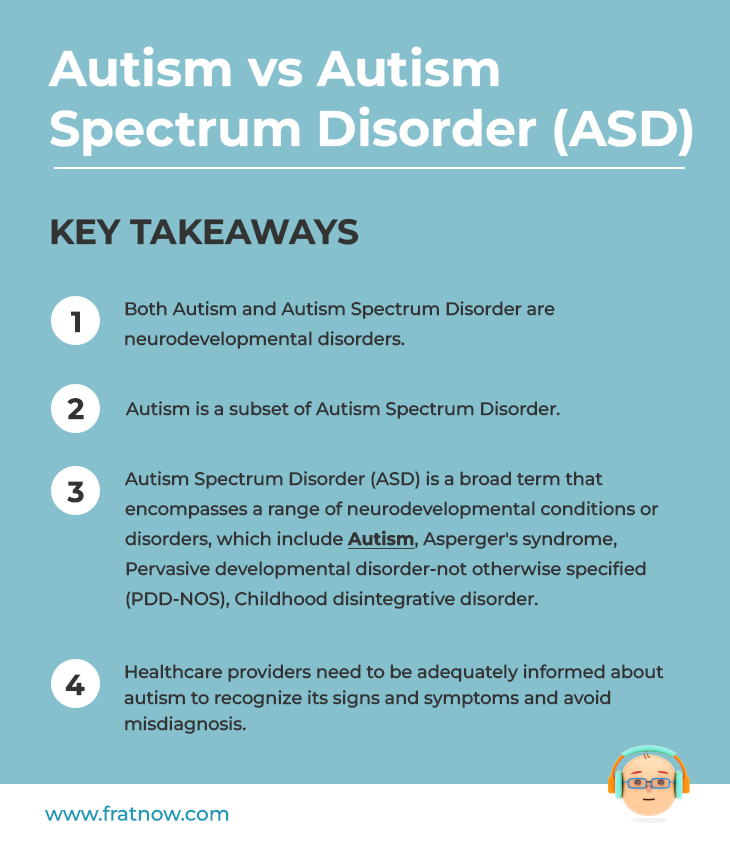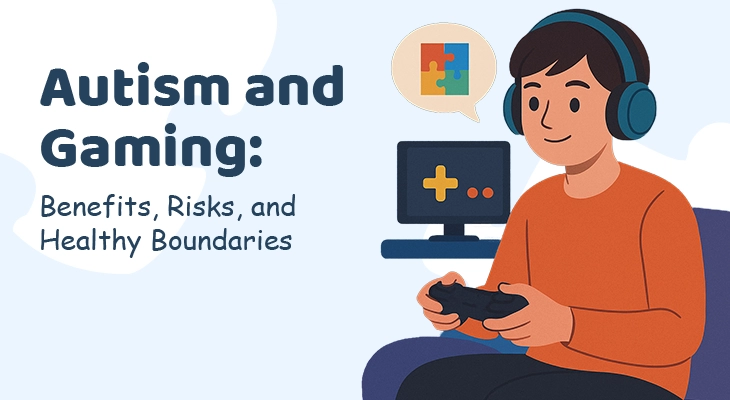
Download Download & share this Knowledge card in your network [Free Download]
Introduction
For those newly navigating the world of autism, understanding the terminology can be a bit confusing. While the terms “autism” and “autism spectrum disorder” (ASD) are often used interchangeably, this is incorrect. While the two are closely related, there’s a subtle but important distinction between the two.
Table of Contents
- Introduction
- What Is Autism?
- What Is Autism Spectrum Disorder (ASD)?
- When Can The Terms “Autism” And “Autism Spectrum Disorder” Be Used Interchangeably?
- The Benefits Of Using “Autism” And “Autism Spectrum Disorder” Interchangeably
- A Unified Diagnosis: The Birth Of Autism Spectrum Disorder
- The FRAT® Test: A Potential Tool For Early Identification
- Did You Know
- Conclusion
- References
To truly understand the nuances of autism, it’s essential to grasp the distinction between the terms “autism” and “autism spectrum disorder” (ASD). Let’s delve into the definitions of these terms to gain a clearer understanding.
What Is Autism?
Autism is a complex neurodevelopmental disorder characterized by challenges in social interaction, communication, and repetitive behaviors. It often manifests as difficulties in understanding social cues, engaging in conversations, and forming relationships.
What Is Autism Spectrum Disorder (ASD)?
Autism Spectrum Disorder (ASD), on the other hand, is a broader term that encompasses a range of neurodevelopmental conditions or disorders, which include:
- Autism
- Asperger’s syndrome
- Pervasive developmental disorder-not otherwise specified (PDD-NOS)
- Childhood disintegrative disorder
It’s called a spectrum because it affects individuals in different ways and to varying degrees.
As you can see, everyone diagnosed with autism is also considered to be on the autism spectrum, as autism is a specific type of ASD. However, not everyone with ASD will meet the criteria for a classic autism diagnosis. Therefore, while the terms are often used interchangeably, it’s important to recognize the nuanced differences between them.
When Can The Terms Autism And Autism Spectrum Disorder Be Used Interchangeably?
People often use the terms “autism” and “autism spectrum disorder” interchangeably due to a few reasons:
- Common Usage: The term “autism” has been widely used for many years, and it’s often a more familiar term for people who are not familiar with the specific nuances of the diagnosis.
- Oversimplification: Using a single term can simplify discussions and avoid complex explanations, especially in casual conversations. For example, if someone says, “My child has autism,” they may be referring to a specific diagnosis of autism or a broader ASD diagnosis, but this level of specificity might not be necessary in that context.
- Overlapping Symptoms: Many of the core symptoms of autism, such as social communication difficulties and repetitive behaviors, are shared across the autism spectrum.
- Lack of Awareness: Not everyone is aware of the nuances between the two terms, leading to their interchangeable use.
- Evolving Understanding: As our understanding of autism has evolved, the diagnostic criteria have broadened, leading to a more inclusive definition of ASD. Thus, when discussing the challenges faced by individuals with autism, the term “autism” may be used to refer to the general population of individuals with ASD.
However, it’s important to remember that using the terms interchangeably can sometimes lead to misunderstandings, especially when discussing specific diagnoses or treatment plans. While the terms are often used interchangeably in casual conversation, it’s crucial to be mindful of the specific diagnosis when discussing clinical or research contexts.

Download Download & share this infograph card in your network [Free Download]
The Benefits Of Using "Autism" And “Autism Spectrum Disorder” Interchangeably
While using the terms “autism” and “autism spectrum disorder” interchangeably can sometimes lead to misunderstandings, there are also advantages to this practice:
- Broader Understanding: The term “autism” is more widely recognized and understood by the general public. Using this term can help raise awareness and promote empathy.
- Focus on Shared Experiences: By using a single term, we can emphasize the common experiences and challenges faced by individuals with different diagnoses within the autism spectrum.

Download Download & share this infograph card in your network [Free Download]
A Unified Diagnosis: The Birth Of Autism Spectrum Disorder
The term “Autism Spectrum Disorder” (ASD) was introduced in the Diagnostic and Statistical Manual of Mental Disorders, Fifth Edition (DSM-5), published in 2013. It is a widely used manual published by the American Psychiatric Association that provides a standard classification system for mental disorders. The DSM-5 is used by mental health professionals to diagnose mental disorders, including autism spectrum disorder. It outlines the specific criteria that must be met for a diagnosis to be made.
The primary reason for introducing this term was to recognize the wide range of symptoms and severity levels associated with autism. Previously, different diagnoses like autistic disorder, Asperger’s syndrome, and pervasive developmental disorder-not otherwise specified (PDD-NOS) were used. However, these categories often overlapped, leading to confusion and inconsistency in diagnosis.
By combining these diagnoses under the umbrella term “Autism Spectrum Disorder,” the DSM-5 aimed to provide a more comprehensive and accurate framework for understanding and diagnosing autism. A single diagnostic approach recognizes the wide range of symptoms and severity levels that can characterize autism, emphasizing the spectrum nature of the condition and reducing diagnostic confusion.
You might also be interested in:
The FRAT® Test: A Potential Tool For Early Identification
Early identification and intervention are crucial for optimal outcomes for individuals on the Autism Spectrum Disorder. Conditions like folate deficiency can impact development, and the FRAT® test can help identify these issues early on.
The Folate Receptor Autoantibody Test (FRAT®) can be a valuable tool in identifying potential folate transport issues that could be contributing to and other developmental concerns in children on the Autism Spectrum Disorder. Read our blog What is FRAT® and the role FRAT® plays in Autism to discover more about this tool and its importance in the early identification of autism.
Here’s why the FRAT® test is relevant:
- Folate deficiency and Autism Spectrum Disorder: Research suggests a potential link between folate deficiency and certain developmental issues in children on the autism spectrum disorder.
- Folate and the nervous system: Folate is a vital vitamin for proper nervous system function and development.
- FRAT® and Folate Transport: The FRAT® test specifically detects autoantibodies that may interfere with folate transport into the brain.
Early detection and intervention are key. If the FRAT® test identifies potential folate transport issues, a healthcare professional can recommend appropriate treatment plans, such as alternate folate supplementation, to address the underlying cause and potentially improve developmental outcomes.
For more on how folate plays a crucial role in early intervention, read our blog The Role of Folate in Brain Development: Why It Matters and How it Could Impact Autism.
Conclusion
By understanding the nuances between “autism” and “autism spectrum disorder,” we can foster empathy, promote inclusivity, and advocate for the needs of individuals with autism. As our understanding of autism continues to evolve, it’s essential to stay informed and challenge misconceptions. By working together, we can create a more compassionate and accepting world for all.
Let’s continue to advocate for the rights and well-being of individuals on the autism spectrum disorder, and work towards a future where they are valued, respected, and celebrated.







